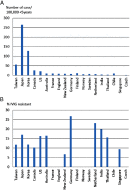The global epidemiology of Kawasaki disease: Review and future perspectives
- PMID: 29564341
- PMCID: PMC5856963
- DOI: 10.21542/gcsp.2017.20
The global epidemiology of Kawasaki disease: Review and future perspectives
Abstract
Kawasaki disease (KD) is one of the most common childhood vasculitides and may lead to coronary arterial complications. KD has been reported in more than 60 countries over five continents. Previous publications have provided a comprehensive description of the epidemiologic features of KD including incidence, age of onset, seasonal trends, and rates of cardiac lesions. However, the interactions among the KD patients, time (seasons) and place have been less well studied. We review the current global epidemiology of KD and focus on the longitudinal changes in incidence, seasonality and response to intravenous immunoglobulin (IVIG) therapy.
Figures
References
-
- Newburger JW, Takahashi M, Gerber MA, Gewitz MH, Tani LY, Burns JC, Shulman ST, Bolger AF, Ferrieri P, Baltimore RS, Wilson WR, Baddour LM, Levison ME, Pallasch TJ, Falace DA, Taubert KA, Committee on Rheumatic Fever, Endocarditis, and Kawasaki Disease. Council on Cardiovascular Disease in the Young, American Heart Association Diagnosis, treatment, and long-term management of Kawasaki disease: a statement for health professionals from the Committee on Rheumatic Fever, Endocarditis, and Kawasaki Disease, Council on Cardiovascular Disease in the Young, American Heart Association. Pediatrics. 2004;114(6):1708–33. - PubMed
-
- JCS Joint Working Group Guidelines for diagnosis and management of cardiovascular sequelae in Kawasaki disease (JCS 2008)–digest version. Circ J. 2010;74(9):1989–2020. - PubMed
-
- Kawasaki T. Acute febrile mucocutaneous syndrome with lymphoid involvement with specific desquamation of the fingers and toes in children. Arerugi. 1967;16(3):178–222. - PubMed
-
- Kim GB, Park S, Eun LY, Han JW, Lee SY, Yoon KL, Yu JJ, Choi JW, Lee KY. Epidemiology and clinical features of Kawasaki disease in South Korea, 2012–2014. Pediatr Infect Dis J. 2017;36(5):482–485. - PubMed
Publication types
LinkOut - more resources
Full Text Sources
Other Literature Sources

